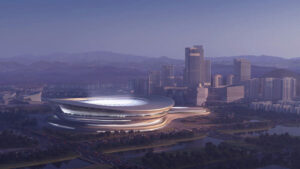Zaha Hadid Architects (ZHA) has secured the contract to design Hangzhou International Sports Centre – a project which will include a 60,000-seat football stadium, 19,000-seat arena and an aquatics centre.
Located within the Chinese city’s Future Science and Technology Cultural District, the sports centre establishes a new riverfront park and public plazas with direct access to Hangzhou’s expanding metro network. ZHA has won the contract following a design competition.
Accommodating Hangzhou’s growing population, the International Sports Centre’s design aims to provide a variety  of facilities for grassroots players through to professional athletes. The compact design of each venue, together with their orientation and composition, allows almost half of the site to be transformed into new public spaces for the city. Integral to the district’s urban plan and the natural landscapes along the riverbank, the centre incorporates new parks and gathering places for events, recreation and relaxation.
of facilities for grassroots players through to professional athletes. The compact design of each venue, together with their orientation and composition, allows almost half of the site to be transformed into new public spaces for the city. Integral to the district’s urban plan and the natural landscapes along the riverbank, the centre incorporates new parks and gathering places for events, recreation and relaxation.
As the largest venue within the centre, the 135,000 sq.m football stadium is situated on the eastern side of the new park, facing the city. Located to the west and south of the stadium, the indoor arena and aquatics centre are connected to the stadium by the centre’s layered podium that weaves through the site.
Informed by the terracing of the tea farms on Hangzhou’s surrounding hillsides, the striated 45,000 sq.m podium houses the sports centre’s ancillary facilities that are shared between the venues including training and fitness halls, locker rooms and offices, as well as shops, restaurants, and cafes overlooking the podium’s courtyard and terraces.
ZHA said that unlike the solid façades of most stadiums, the façade of the Hangzhou International Sports Centre stadium is open to the exterior with louvres sheltering terraces that host a variety of food and beverage outlets offering panoramic views across the city.
Designed to FIFA standards, the stadium’s seating bowl is configured to bring spectators as close as possible to the field of play and ensure unrestricted views from every seat, creating an intense matchday atmosphere. These programmatic requirements define geometries that are expressed as undulations within the louvred façade.
ZHA said: “The stadium’s louvred façade blurs the boundary between interior and exterior. The louvres’ materiality and detailing give the stadium a stratified, geological appearance of solidity when viewed from nearby. When viewed from a distance, the louvred façade becomes transparent, connecting the public spaces beneath the stadium’s seating bowl with the city.”
With a capacity of 19,000 seats, the 74,000 sq.m indoor arena can operate independently to the stadium and is designed with maximum operational flexibility to host many of China’s most popular spectator sports such as basketball, in addition to large music and cultural events.
Situated on the western edge of the park, the 15,000 sq.m aquatics centre incorporates two 50-metre pools suitable for competitions, training and teaching at all levels.
Located within the warm temperate climate of Hangzhou, the International Sports Centre has been designed to the highest 3-Star rating of China’s Green Building Program with each venue using natural hybrid ventilation most of the year. ZHA said annual solar irradiation analysis has determined the composition of the façade’s external louvres, while photovoltaics will harvest solar power for all venues. Ground heat exchange and recovery systems will seek to ensure efficient operations for all facilities.
The centre’s landscaping establishes wetlands along the riverbank that are integral to the district’s drainage network. Collecting and channelling rain and grey-water for filtration and re-use, this network uses aquatic flora and fauna native to the region to naturally remove contaminants.
To reduce the embodied carbon throughout the project, ZHA said its optimisation processes minimise the amount of materials required for the structure and are integrated with local supply chains and procurement systems that have been developed to increase the recycled and recyclable content.
The International Sports Centre is set to be the latest addition to Hangzhou’s facility portfolio. In July, the Olympic Council of Asia (OCA) announced that Hangzhou’s postponed Asian Games will now take place from September 23 to October 8 next year.
The multi-sport event had been due to take place from September 10-25 this year but the Games were postponed in May, with OCA citing the “pandemic situation” in China and the size of the event.
All venues for the Asian Games were completed in April and cleared to begin hosting test events. Some 56 venues are due to be used during the Asian Games and the Asian Para Games. Twelve venues have been newly constructed, while 26 have been reconstructed, nine are existing facilities and a further nine have been set up as temporary destinations.
